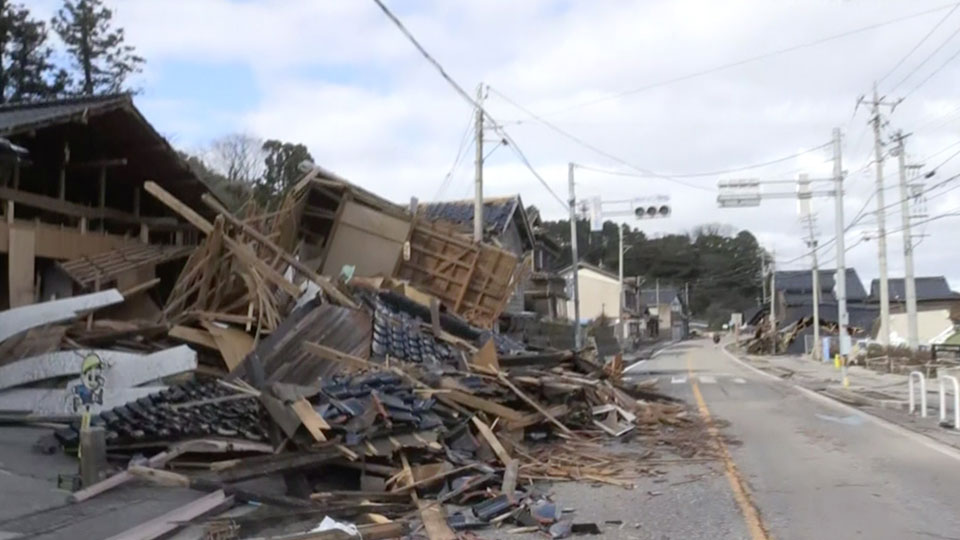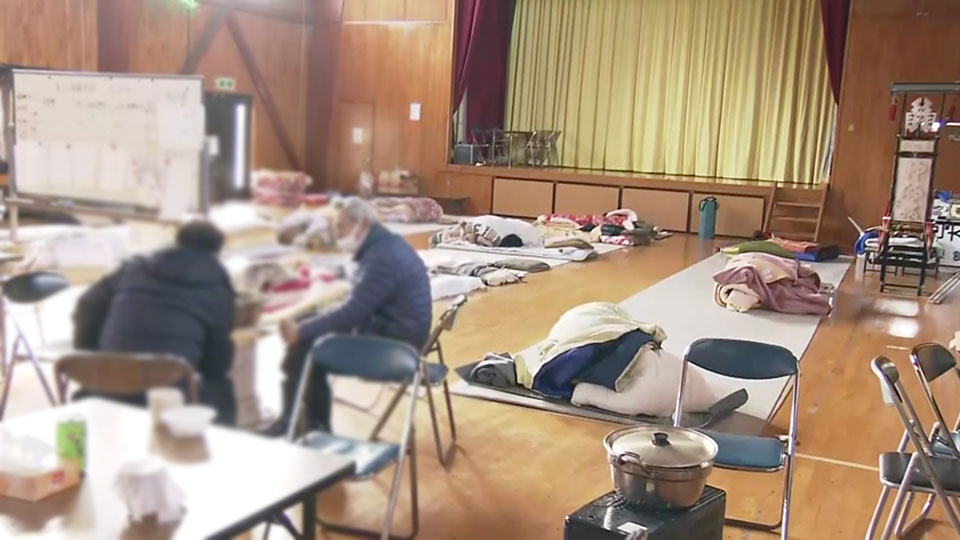SDF medical team arrives by helicopter
In Otani Town, Suzu City, 190 people remain stranded because of the badly damaged roads.

A medical team consisting of one Self-Defense Force doctor and three paramedics arrived by helicopter on Thursday. The team stayed about four hours and treated more than 20 people.
The team examined residents for injuries caused by the earthquake and whether the symptoms of chronic diseases had worsened. They also prescribed painkillers and applied compresses.

A 68-year-old man who received medical treatment said he was saved because he couldn't go to his house to get his medicine as it was destroyed by the quake, and he couldn't go to a hospital.
An 81-year-old woman said she was given pain relief for the injuries she suffered from the quake when she found herself wedged between a chest of drawers. She also said the quake destroyed her fish shop.
One resident who came for help, a diabetic, was told the team did not have necessary medicine. She said she is worried as she only has a week supply of her prescription medicine.
Resident reports from isolated district
Another district, Shitura in Wajima City, which has 350 residents, cannot be reached by private vehicles due to the bad roads. The district also has no water or power.
Higashi Eiichi, a Shitura resident, sent a video to NHK on January 10, after mobile phone services were restored, to let people know the situation the isolated people there were facing.
The 73-year-old was outside the district when the quake hit. He walked back to his home that day.
The video he sent on Thursday shows him explaining that he was able to do the laundry for the first time in four days. He said he washed his clothes by hand as there is no electricity to run washing machines.
The videos sent by Higashi show the quake damage.
In an online interview, Higashi said the situation is critical. He said, "We have no idea when the stay in the shelter ends. There are many elderly people who are around 90 at the community hall. I'm worried about their health."

Once isolated town
The town of Machino in Wajima City was cut off at one point due to a landslide.
An NHK crew was able to reach the district of Sosogi in Machino on Thursday and spoke with the community leader.

About 60 to 70 percent of 120 Sosogi's residents are 65 or older, and most fled to the evacuation center immediately after the quake.
They had no electricity or water, so they helped each other. The residents brought fuel from their homes. They used buckets to fetch spring water from the nearby mountains.
The SDF delivered relief supplies to Sosogi on January 4, three days after the quake. The next day, the road became passable and the isolation ended.
But the area is still without electricity or water. About 50 people remain at the evacuation center as their homes were destroyed in the quake.

Residents cannot use flush lavatories, and they have not been able to take a bath since the quake, bringing concerns of worsening sanitary conditions.
One evacuee said that, although she has not taken a bath in ten days, now is not the time to talk of such luxuries.
Sosogi district chief Tone said he hopes that residents will quickly find a place where they can sleep in their own beds, have meals and feel at ease.
Helicopters owned by private firms bring help
A company based in Okayama City that operates helicopters has been providing support in areas hit by the Noto Peninsula quake since January 3 at the request of the Japan International Agency for Disaster Countermeasures, an organization engaged in disaster response.
The company says four of its helicopters are being used to transport residents to safer places, as well as to deliver food and water to isolated areas on the Noto Peninsula.

On Thursday alone, the company said it transported about 20 residents from an isolated district in Wajima City to Hakui City.
Noto Airport temporarily resorted
Noto Airport, which had been closed due to the quake, was temporarily reopened on Thursday, allowing SDF aircraft to take off and land.

The prefectural government and the land ministry say the temporary reopening will enable the facility to be used as a base for transferring disaster victims to secondary evacuation centers and transporting supplies.
Meanwhile, Ishikawa Prefecture officials say that commercial aircraft will be able to fly between Noto and Haneda airports on or after January 25, at the earliest.
Ishikawa Prefecture: Isolation may be prolonged
Governor Hase Hiroshi of Ishikawa Prefecture said at a disaster response task force meeting on Thursday that National Route 249 and the prefectural road, Wajima Urakami Route, are not expected to reopen for the time-being. He said many people remain isolated in villages such as Nishio and Kounosu in Wajima City.
Hase said, in order to prevent disaster-related deaths, consideration should be given to relocating isolated residents to places away from the disaster-stricken areas, such as Kanazawa City.

The prefectural government says people have to come to the "mid-stage" facility by helicopter, and then be transferred to secondary evacuation centers.
After the task force meeting, Hase said, "The transfer will take two days. It's below freezing and snow is expected." He wants the residents to quickly decide whether they want to relocate.
